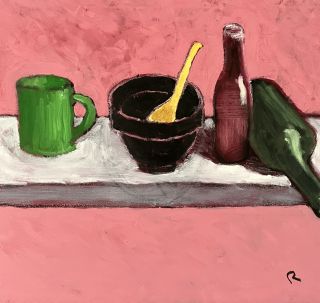Friends
Life, Art, Friendship and Other Mysteries
A Personal Perspective: Finding a friend in his artwork when he's no longer around.
Posted August 9, 2024 Reviewed by Abigail Fagan
My friend Dave Rogers was an artist. When he was in his thirties, he was crossing a street in Washington, D.C., looked down at his hand and had a sudden desire to draw a picture of it. Up until then he had never had any desire to draw or create art. It was a crucial moment of opening in his life: He was coming from his AA sponsor’s apartment where he had been giving away his fourth step—i.e., reading his “fearless and searching moral inventory of himself,” as they say in AA.
After he had the desire to draw his hand, he went to an art supply store and bought a pad of paper and a pencil, went home, and drew a sketch of his hand, and that was the beginning of the rest of his life, his real life, as he called it. He took art classes, bought an old van and drove it to Taos and lived in a room in a Native American Indian church while he painted a simple depiction of Christ on the wall of the chapel, his first commission. He lived in Argentina for 10 years so he could live cheaply and paint. He turned his apartment in Ecumenical Towers, the housing project for the elderly in downtown Iowa City, where he spent his last 12 years, into an art studio. During his last seven years, he was mostly housebound due to the leukemia that eventually killed him. But he never stopped painting, and he was always cheerful and engaged with life, perhaps because he was painting. He outlived his prognosis by at least five years, and I thought it was in part the painting that was keeping him alive.
He died recently, on June 4. He left a lot of art behind when he died, and some of it is sitting in my upstairs closet. Right now I’m looking at one of his paintings, an oil painting on an 18 by 24 inch canvas, resting on the floor across from me in front of my upstairs bookcase. It’s a still life depicting a set of objects sitting on a shelf. There’s a black bowl with a wooden spoon resting in the bowl, two bottles to the right of the bowl—a smallish reddish-purple one standing upright; a green one lying on its side, the end of its neck protruding beyond the edge of the shelf it’s resting on—there’s a green coffee cup to the left of the black bowl.
There’s something about this painting, something in this painting, that makes it feel alive to me. Maybe it’s the light and shadow—there are patches of light on the glass bottles, foreshortened shadows underneath them—or maybe it’s something else. All I can say is that I feel something living in it, this depiction of objects, which itself is an object—a picture created with paint on a rectangular piece of canvas. I feel something living in it, and it’s not just that it’s art, that maybe all art that’s any good captures something living, some essence of life.
When I look at this painting I feel my friend’s presence in it. It’s as if his attention is still here, the close careful attention he paid when he was painting this picture, as if his attention is captured, like lightning in a bottle, and his attention was him, is him, somehow, still. When I look at this painting, I recognize his exact attention, the animated awareness I saw in his face when I talked to him on FaceTime, as I did almost every day for seven years. I see his attention in the details, the rim on the black bowl, the handle of the cup, the patches of shine on the glass bottles, even in his signature, a little back-tilted R in the bottom right corner of the painting. Maybe it’s that signature, that friendly and somehow insouciant back-tilted R, that is giving me this sense that Dave himself is still somehow here, cheerful and present.
People are always saying that when someone you love dies, they live on in your memories and in your heart. I’ve never known what that meant, have never felt even slightly comforted by it. But now, sitting here on the futon in my upstairs study looking at Dave’s painting, I’m finally sort of getting what that means. Not that I’m understanding it, the way you take in a piece of language and assign it some nailed-down meaning. But I’m kind of getting some felt sense of how it can be true that our dead loved ones live on in our hearts.
I feel like Dave is still living in some mysterious way that goes beyond how we usually think of living, and that also goes beyond how I like to think about survival after death—some existence in an afterlife that’s not very far away. I do believe that Dave with his warmth and curiosity, his sparkling energy, must still be alive somehow, somewhere, in some afterlife we can’t understand.
But what I really want to say about this is that it’s all a mystery. Life is a mystery. Death is a mystery. Art is a mystery. We can’t understand any of it, but the fact that we don’t understand it doesn’t mean that it doesn’t exist. Because here it is, right on the canvas sitting in front of me, the black bowl with the wooden spoon resting in it, the green cup and the two bottles. Except it’s not a real bowl or cup or two bottles. It’s a depiction of those things that was somehow magically created by Dave, that somehow arose out of Dave’s consciousness. And if that isn’t evidence that it’s all a mystery, that there’s no way we can know where life is and where it isn’t, no way we can know where Dave himself is and isn’t, I don’t know what is.



